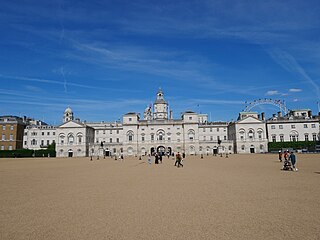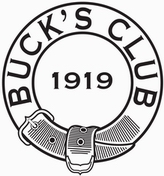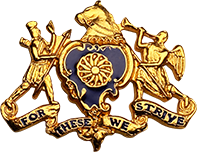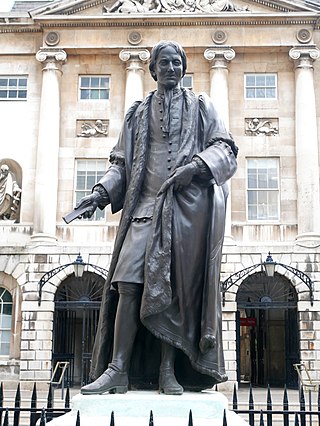
Horse Guards is a historic building in the City of Westminster, London, between Whitehall and Horse Guards Parade. It was built in the mid-18th century, replacing an earlier building, as a barracks and stables for the Household Cavalry. The current and previous buildings were, between the early 18th century and 1858, the main military headquarters for the British Empire. Horse Guards originally formed the entrance to the Palace of Whitehall and later St James's Palace; for that reason it is still ceremonially defended by the King's Life Guard.

Chelsea Arts Club is a private members' club at 143 Old Church Street in Chelsea, London with a membership of over 4,000, including artists, sculptors, architects, writers, designers, actors, musicians, photographers, and filmmakers. The club was established on 15 November 1890, as a rival to the older Arts Club in Mayfair, on the instigation of the artist James Abbott McNeill Whistler, who had been a member of the older club.
The Portland Club is a London card-playing game club and the recognised early authority on the games of whist and bridge. It is reputedly the oldest card club in the world. Founded in October 1814 as the Stratford Club, 1, Stratford Place.

White's is a gentlemen's club in St James's, London. Founded in 1693 as a hot chocolate shop in Mayfair, it is London's oldest club and therefore the oldest private members' club in the world. It moved to its current premises on St James's Street in 1778.

The Devonshire Club was a London gentlemen's club which was established in 1874 and was disbanded in 1976. Throughout its existence it was based at 50 St James's Street. The major Liberal club of the day was the Reform Club, but in the wake of the Reform Act 1867's extension of the franchise, the waiting list for membership from the larger electorate grew to such an extent that a new club was formed to accommodate these new Liberal voters. The clubhouse was on the western side of St James's Street. The original intention was to call it the 'Junior Reform Club', along the model of the Junior Carlton Club formed in 1866, but complaints from the Reform Club's members led it to being named the Devonshire, in honour of its first chairman, the Duke of Devonshire, an aristocrat from a long line of Liberals.

Buck's Club is a gentlemen's club in London, located at 18 Clifford Street, established in June 1919. P. G. Wodehouse mentions it in some stories and modelled his Drones Club mostly after Buck's. It is probably best known for the Buck's Fizz cocktail, created there in 1921 by its bartender McGarry.

Boodle's is a gentlemen's club in London, England, with its clubhouse located at 28 St James's Street. Founded in January 1762 by Lord Shelburne, who later became Prime Minister of the United Kingdom and then 1st Marquess of Lansdowne, it is the second oldest private members' club in London and in the world.

The First Troop Philadelphia City Cavalry, also known as the First City Troop, is a unit of the Pennsylvania Army National Guard. It is one of the oldest military units in the United States still in active service and is among the most decorated units in the U.S. Army. Accordingly, the Troop operates under a number of principles of self-governance unique in the U.S. military, including the election of unit members and officers, voluntarily forgoing pay for military service to the country, continuing to practice horse cavalry skills and tactics, and recruiting a high percentage of its members from veterans of prior active duty service across all branches, as well as older civilian mid-career professionals.
The Guards Club, established in 1810, was a London Gentlemen's club for officers of the Guards Division, originally defined by the club as being the Coldstream Guards, Grenadier Guards or Scots Guards, traditionally the most socially elite section of the British Army. Officers of the Welsh and Irish Guards were not able to join until the second half of the 20th century. Its clubhouse at 70 Pall Mall was the first to be built on that street, which later became noted for its high concentration of clubs; earlier clubs had been focused on the adjoining St James's Street.

The St James's Club was a London gentlemen's club which operated between 1857 and 1978. It was founded by two leading diplomats and its members continued to be largely diplomats and authors. It was first established in Bennet Street, and after a brief spell in Mayfair, moved to 106 Piccadilly by 1868. In the final quarter of the twentieth century many gentlemen’s clubs of London suffered from declining membership, and in 1978 the St James's Club merged with Brooks's Club and vacated its premises.

The Constitutional Club was a London gentlemen's club, now dissolved, which was established in 1883 and disbanded in 1979. Between 1886 and 1959 it had a distinctive red and yellow Victorian terracotta building, designed by Robert William Edis, at 28 Northumberland Avenue, off Trafalgar Square.
The City University Club is a gentlemen's club in the City of London, established in 1895. From its foundation until 2018 it operated from the top three floors of 50 Cornhill, of what was Prescott's Bank, a 1766 private bank which became a branch of part of the NatWest banking group. This arrangement was quite specifically intended by and between the bank's partners and the club of which they were founding members when the building was designed. The branch closed in 1999 and was turned into a pub of the Fullers chain.

The Junior Carlton Club was a London gentlemen's club, now dissolved, which was established in 1864 and was disbanded in 1977.

The Conservative Club was a London gentlemen's club, now dissolved, which was established in 1840. In 1950 it merged with the Bath Club, and was disbanded in 1981. From 1845 until 1959, the club occupied a building at 74 St James's Street where the Thatched House Tavern had previously stood.
The Junior Constitutional Club was a political London gentlemen's club founded in 1887, and located at 101 Piccadilly. It was aligned to the Conservative party, with members having to pledge support. Heavy over-subscription for the Constitutional Club which had opened in 1883 led to the creation of a further mass-membership Conservative club.

The Cavalry and Guards Club is a London gentlemen's club, at 127 Piccadilly, situated next to the RAF Club.
The American Club was a London gentlemen's club, now dissolved. It was established to provide a centre for London's growing expatriate American community, with the inaugural meeting being held at the Savoy Hotel on 21 October 1918.

Crockford's, the popular name for William Crockford's St James's Club was a London gentlemen's club, now dissolved. It was established in 1823, closed in 1845, re-founded in 1928 and closed in 1970. One of London's older clubs, it was centred on gambling and maintained a somewhat raffish and raucous reputation. It was founded by William Crockford who employed Benjamin Wyatt and Philip Wyatt to construct the city's most opulent palace of gentlemanly pleasure, which opened in November 1827. and he employed two of London's finest chefs of the time, Louis Eustache Ude and then Charles Elmé Francatelli to feed its members, food and drink being supplied free after midnight.

The Cavalry of the Empire Memorial, also known as the Cavalry Memorial, is a war memorial in Hyde Park, London. It commemorates the service of cavalry regiments in the First and Second World Wars. It became a Grade II listed building in 1987, and was promoted to Grade II* in November 2014.

A statue of Thomas Guy stands in the forecourt of Guy's Hospital in the borough of Southwark in Central London. The statue is Grade II listed.















